- Probable factors for dishwasher breakdown
- The dishwasher does not wash the dishes well
- Overflowing water
- Problems with water heating
- Dishwasher repair: drain does not work
- Voltage breaks down on the body
- The dishwasher does not pick up detergents
- No power supply
- Abnormal sounds of work
- Dishwasher Drying Does Not Work
- Water leaks to the floor
Once, like any household appliances, the dishwasher gives a signal of a malfunction: it does not respond to the start button, the water drain is broken, and a leak is detected. Do not panic and rush to call specialists. In many cases, you can repair your dishwasher at home yourself. Below we will tell you in detail about the most common malfunctions of a home dishwasher, and we will tell you the most reliable ways to repair these breakdowns with your own hands.
![]() See also - How to replace the circulation and drain pump in a dishwasher
See also - How to replace the circulation and drain pump in a dishwasher
Probable factors for dishwasher breakdown
When the dishwasher has been in operation for more than five years, and the warranty period has long expired, any worn part can cause equipment breakdown. But what to do when the technique was acquired relatively recently? If the purchase of a household dishwasher is still fresh, malfunction factors may be as follows:
- The equipment was assembled poorly or the condition of some parts was already faulty. This often happens with cheap Chinese manufacturers with a little-known reputation.
- A lot of uncleaned food remains on the dishes that are loaded inside the machine. This clogs the filters. If the dishes are very dirty, the machine often fails, which makes it necessary to rinse the dishes with your own hands.
- The power socket for the machine does not work. Quite a common cause of a malfunction.
- Often, dishwasher repairs are caused by an initially incorrect connection of water communications: the drain hose is of an unacceptable length or the hose with cold water was not securely fastened.
- An unreliable dishwashing detergent is being used. As a result, the dishes are poorly washed out of grease or generally remain dirty.
- If the equipment does not turn on, the door may not close tightly. The machine starts only when the door is tightly closed until it clicks. When the door does not close tightly even when the latch is triggered, such malfunctions are attributed to the manufacturers of this type of kitchen equipment.
- A malfunction of the dishwasher is caused by improper loading of the dishes. In this case, the washing quality of cutlery in the upper section and pots on the lower shelf will deteriorate significantly. The rules for the operation of equipment provide recommendations for the proper loading of dishes and cutlery: the upper section is filled mainly with cups and plates, the lower one - with pots. It is necessary to clarify that cups and glasses should be stacked upside down.
When these factors are not at the root of the machine's malfunction, it is most likely that the reason lies in the breakdown of specific parts.
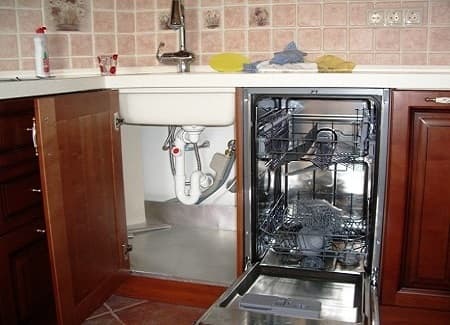
The dishwasher does not wash the dishes well
There is a possibility of the following problem: the machine is set to the desired operating mode, each indicator is working properly, the sound of water movement is heard, the heating process is not worth it, but the dishes are not washed. There are several reasons whydishwasher does not wash dishes well.
Firstly, the filter located at the very bottom of the washing compartment is often clogged. In such a situation, repairing dishwashers on their own will only consist in removing the filter and cleaning it.
Secondly, clogging of the nozzle occurs no less often. This will result in little or no hot water spraying. Such breakdowns negatively affect the water supply pressure inside the chamber. Therefore, the dishes will not wash well. In such situations, an ordinary toothpick saves, with which the nozzle holes are cleaned. Also, the "shoulder" of the nozzle itself may not rotate. In this case, you should pay attention to the circulating pump. Its breakdown is also not uncommon.
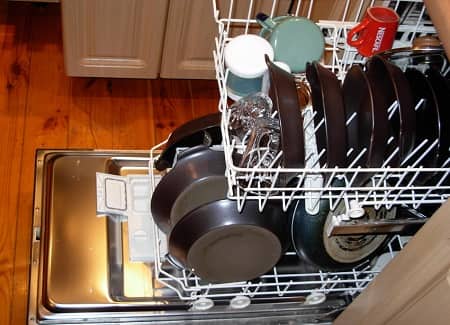
Thirdly, as already mentioned, the circulating pump breaks down. Through it, water flows to the nozzles. In this case, repairing dishwashers on your own is somewhat complicated due to the severity of the breakdown. To set up equipment, a complete replacement of the defective part will be required. To repair the dishwasher with your own hands, you need to open access to the pump located at the bottom of the chamber, disconnect all existing communications and fasteners from it. Then install a working part.
How to understand that the reason for the failure of equipment is precisely in the pump? When the water is full and the machine has stopped, it is most likely that the pump is faulty.
Overflowing water
Such a breakdown is caused by a malfunction of the water level sensor (pressure switch). It is located at the bottom of the machine. You will need to unfold the dishwasher to get to the water level sensor. Then you can easily replace it with a serviceable pressure switch. You should also be careful if the element is in the on mode and water enters the chamber without hindrance, the electromagnetic valve is broken. It is he who must stop the flow of water if necessary. Replacing the solenoid valve with your own hands is not difficult.
Problems with water heating
When the dishwasher breaks down and does not heat or overheat the water, it is recommended to pay attention to the following. In case of overheating, the breakdown lies in the temperature sensor, which is why the water overheats. As a result, there is an excess of steam and a stoppage of the dishwasher.

If the water does not heat up and remains cold or lukewarm, there are several faults that can cause this phenomenon:
- defective temperature sensor;
- low water pressure at the nozzles or pump;
- malfunction of the heating element (you should make sure that it is working properly with a multimeter).
Dishwasher repair: drain does not work
When the dishwasher is working properly in everything, but the waste water does not drain well or even accumulates inside the washing compartment, the malfunction may be hidden in the drain pump and therefore does not drain.
To fix a similar problem with your own hands, you should conduct a detailed inspection of the pump for clogging and winding resistance. Stagnation of water in the machine can happen precisely because the pump is clogged. When it is found that there is no debris in the pump, it is necessary to inspect the entire drainage communication, not excluding the siphon. Most likely, the drain channel could be clogged. In this case, you should simply remove all blocking elements.
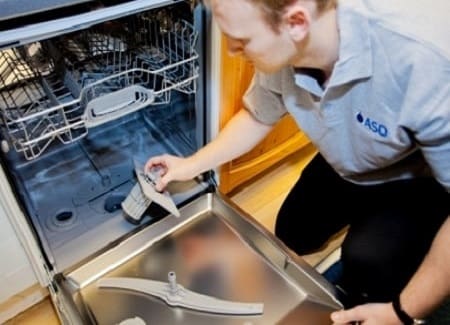
Sometimesthe dishwasher does not drain the water, because the position of the drain hose in relation to the level of the machine is too high. After turning off the pump, part of the used water flows back into the washing compartment of the machine.
Voltage breaks down on the body
When the dishwasher turns on and an electric current passes to the body of the equipment, it is most likely that the cause of the breakdown lies in the malfunction of the heating element. You can fix such a malfunction with your own hands if you carefully examine the heating element for surface damage. If any are found, the heating device should simply be replaced with a new one.
Most often, too hard water properties cause such breakdowns. In addition, the heating element often breaks down when the starting relay does not turn on well.
The dishwasher does not pick up detergents
A frequent defect in the operation of such equipment is a poor intake of detergents, liquid or in the form of a tablet. The reason for this can also be weak water pressure or malfunction of the nozzle, which leads to poor water ingress into the dispenser. In addition, the mechanical valve that controls the washing out of the detergents is often broken. Due to the poor-quality operation of the valve allowing water to pass through, the agent often remains closed for water access. Consequently, the dishwashing performance is reduced.
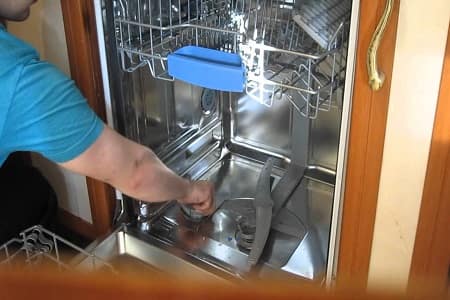
No power supply
When there is no indicator backlight or the dishwasher does not turn on when you press a button, you should check several options for breakdowns:
- outlet malfunction;
- the door has not closed completely, the automatic door lock does not work;
- the network button works;
- breakdown of the mains filter.
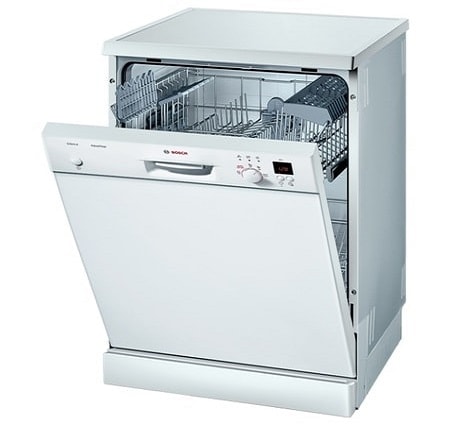
In each of the proposed options, using a multimeter, it is necessary to check the entire electrical circuit for defects. Excluding serviceable elements, a non-working part is detected.
Abnormal sounds of work
Abnormal noise may indicate a damaged motor or pump bearing. Bearing failure is caused by moisture penetration into it through worn out seals. As a result of such violations, an unnatural sound for a dishwasher is produced. To fix such a defect with your own hands, you will need to replace both the bearing itself and the damaged oil seal. Otherwise, such a breakdown will happen again soon.
Dishwasher Drying Does Not Work
Many modern models of dishwashers have a function for drying clean dishes. This process is carried out by a blower installed in the washing chamber. When the machine is working properly, but does not dry the washed dishes, the fan is probably faulty. To fix such a breakdown with your own hands, you should carefully inspect the supply wires and the winding of this part. If necessary, the fan should be replaced with a new one.
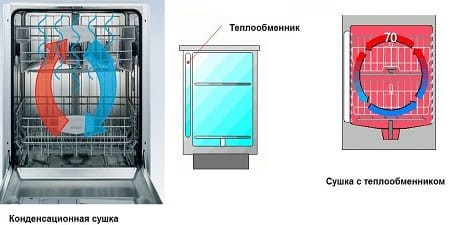
Advice:
Read also: DIY kitchen hood repair
Water leaks to the floor
Another of the most common dishwasher breakdowns is case leakage. There is a possibility of one or more reasons:
- The sealing tape along the perimeter of the door is leaking. The closing tightness is reduced. It is necessary to replace bad seals or clean them of plaque.
- Also, the pump seal can be damaged. Then replacement of the seal is required.
- Poor quality strengthening of drainage and water injection communications. Leaks occur at the junctions.
- On the side of all dishwashers there is a storage tank for water. In some cases, it can leak. In such situations, it must be replaced, since it cannot be repaired.
To accurately locate the leak, it is required to completely detach the dishwasher body. Then, under it, you need to lay out blank sheets of paper. Water droplets on the paper will be visible at the leaks.
![]() See also - Choosing a compact tabletop dishwasher
See also - Choosing a compact tabletop dishwasher

